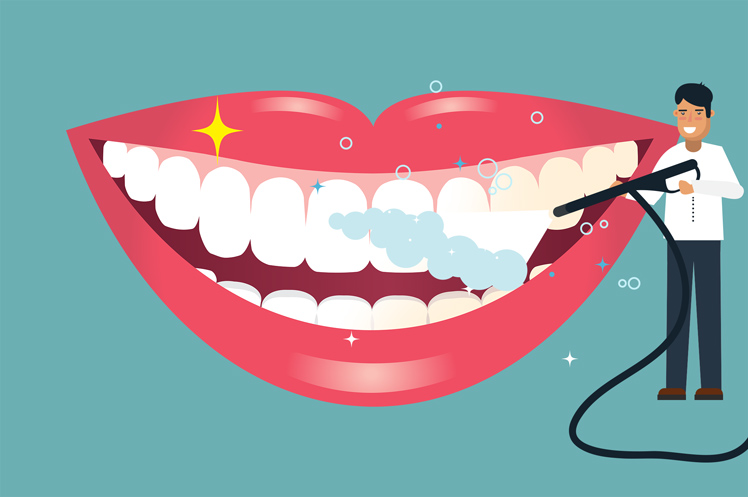Air polishing is a real game changer for patients, it is a growing innovation which can help improve the look of your teeth and prevent disease in the mouth. This procedure is the new buzz topic within the field of dental hygiene, mention ‘air polishing’ to any dental hygienist and I guarantee their eyes will light up.
What is air polishing exactly?
Think of it like a jet wash for the teeth. Air polishing is a minimally invasive technique which uses a mixture of compressed air, water and fine powder to remove unsightly staining and harmful plaque from the teeth. Air polishing can also be used to gently clean underneath the gum line and around orthodontic wires/brackets, implants, crowns, bridges and conventional fillings.
There are different air polishing systems available depending on the results you wish to achieve.
Staining
Staining on the teeth can be caused by a number of things – most commonly tea, coffee, red wine, smoking and chlorhexidine mouthwashes. Traditionally, hygienists had only scalers and abrasive pastes at our disposal to remove these stains, usually meaning a long and sometimes uncomfortable appointment in order to brighten a patient smile. Now, thanks to air polishing treatment, time can be significantly reduced, meaning less time in the dental chair and a more comfortable experience for the patient.
Due to the ‘jet’ action, air polishing systems can also reach into areas where staining can be really difficult to remove, such as in between the teeth. This can give a much better end result when compared to polishing with a paste. With the powders used with this technique also being far less abrasive than pastes, it allows us to thoroughly polish the teeth without causing any unnecessary ‘wear and tear’ to the enamel. So far so good, yes?
So that’s the aesthetic benefit covered, but what about the benefits to your oral health? That’s where air polishing really comes into its own.
Plaque biofilm
Every man and his dog (literally) get plaque biofilm building up on their teeth which is, in very basic terms, a sticky mixture of bacteria, polysaccharides and glycoproteins which adheres to tooth and restoration surfaces. It is the bacteria within this mixture which produce the disease-inducing substances that can cause tooth decay and gum disease. If left behind after brushing, this plaque can also become hardened, both on the superficial surfaces of the teeth and underneath the gum line, something which is then referred to as calculus. For a long time, it was thought that this calculus needed to be removed in its entirety to treat gum disease effectively and this was achieved by cleaning on and underneath the gum line with hand instruments and ultrasonic scalers – a procedure which many patients found to be very uncomfortable. As our knowledge and understanding has developed, it has become evident that it is not the complete removal of calculus which is essential, but rather the removal of the bacteria loaded biofilm which can help in the treatment of gum disease and this is where air polishing fits perfectly into modern dentistry. Air polishing is powerful enough to simply blast away this biofilm, reducing the need for traditional scaling methods.
Due to the super fine particles used in this procedure, it can be safely used around soft tissues to comfortably access below the gum line, obliterating any bacteria in its path and thus helping to prevent disease. In my experience of using an air polishing unit, feedback from patients has been extremely positive with many reporting increased comfort during their routine hygiene treatment and plenty requesting it time after time!
Is air polishing suitable for everyone?
There is a small proportion of patients who air polishing treatment may not be suitable for, including patients with very unstable asthma or other breathing difficulties, patients following a very low sodium diet and those with allergies to any of the ingredients in the powders. Your dentist or dental hygienist will fully consider your medical history when recommending any treatments to you.
Ask your hygienist today!
Of course, twice daily tooth brushing and interdental cleaning still needs to be our first line of defence in the fight against plaque biofilm, but with this effective treatment now in our armoury, we have a reliable and effective tool to help us maintain your sparkling and healthy smile.
About Harriett:
Harriett qualified from the University of Liverpool in 2012 with a BSc in Dental Hygiene and Therapy and has worked for Dr Cummings at Hanford Dental practice since 2013. Her main role at the practice is to complete hygiene treatments, ranging from the basic ‘scale and polish’ to more complex treatments for advanced periodontal disease.
Harriet is dedicated to her patients and particularly enjoys helping nervous patients to feel at ease – it’s always very satisfying when people leave with a smile on their face!
A keen traveller who love the outdoors, Harriet can often be found walking in the countryside when she is not in the practice.
